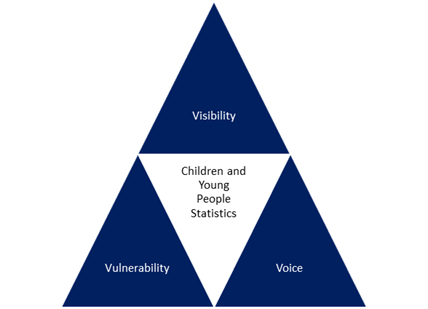Aim and approach
As the independent UK-wide statistics regulator, we are in a unique position to take a broader look at issues of importance to society and to make the case for improved statistics across organisational and government boundaries.
In our regulatory work we often assess official statistics on a particular topic area. Some of these topics are specific to children, for example statistics on educational attainment. Some include children as part of the data collection, for example health statistics.
In this review we have explored the different needs for statistics on children and young people. We have looked at how well they are being met and why statistics on children and young people are important. To do this we have looked across the whole statistical system. We started this review prior to the Covid-19 pandemic.
In this report we have focussed on the need for statistics for children and young people under the age of 18. We have also recognised the need for statistics on young people beyond this age to inform decisions about children and young people and the outcomes associated with them.
Our aim in publishing this review is to add to the evidence base of the strengths and weaknesses of the current official statistics on children and young people and to provide a practical framework for statistics producers looking to make improvements to their statistics. We recognise that there are barriers to making these improvements and plan to explore these further following publication of this report.
Our findings are based on conversations with a range of stakeholders and a review of published literature relevant to statistics and data about children and young people. Full details of the organisations we engaged with during this review can be found in Annex A. Where relevant, we have drawn on our other recently published work and highlighted where issues have been raised through our wider regulatory activities.
Early in these conversations three common themes emerged – that children and young people should be visible in official statistics, that data needs to be available to separately analyse the experiences of those who are vulnerable to poorer outcomes, and that official statistics need to give children and young people a voice including a voice in how their data are used. We have named this approach to considering the needs of children and young people the ‘3Vs’ framework.
- Visibility lens – that statistics are available on children and young people.
- Vulnerability lens – that the experiences of children and young people who are vulnerable to poorer outcomes are collected and analysed separately.
- Voice lens – that statistics reflect the views of children and young people and they have a say in how their data are used.
We first tested these lenses with users and producers of children and young people statistics and asked for feedback in our July 2020 blog. We found they were well supported.
The 3Vs reflect the core principles of the UN Convention on the Rights of the Child. Better visibility of data supports the right to life and development and the right for decisions to be in the child’s best interest. Better data on vulnerable children and young people supports their right not to be discriminated against and for decisions to be in their best interests. A better voice for children and young people in official statistics supports their right to express their opinions in matters that relate to them and their right to privacy through engaging with how their data are used.
We used the 3Vs framework to explore the representation of children and young people in official statistics during the Covid-19 pandemic and published our findings as an interim report in August 2021. We found that the framework provided a useful way of viewing the representation of children and young people in statistics and received positive feedback.
In October 2021 the Northern Ireland Commissioner for Children and Young People advocated the use of the lenses of visibility, vulnerability and voice in their More than a number: A rights based review of waiting times in Northern Ireland report.
In this, our final report, we have looked across a wide range of statistics using the 3Vs of Visibility, Vulnerability and Voice as a framework to explore whether the current statistics are helping society to understand the experiences of children and young people in all aspects of their lives. To support the evidence base for statistics producers and others working in this area we have published our full research evidence. This can be found in Annex B.
We have set out where we consider improvements are required, but have not made any formal recommendations to statistics producers in this report. Following publication of this report we will work with official statistics producers to identify and address any barriers to the improvements we have set out and make specific recommendations as appropriate.
In September 2021 the UK Statistics Authority Inclusive Data Taskforce published its findings. The taskforce made several recommendations that align with the findings of this review. Where relevant, we have referenced these in this report.
We have produced a series of slides to summarise our key findings and our views on improvements from our systemic review into the importance of including children and young people in official statistics. The findings are presented separately for each of the 3Vs in the framework; visibility, vulnerability and voice. We would like to encourage people to share these slides with others and to use them when discussing the findings of the report.


